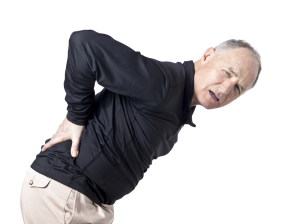Symptoms of low back pain occur first following a physical activity such as heavy lifting, twisting of the back or trauma.
Associated with the back pain is a reduced range of motion in the lower back making it more difficult to do the normal activities such as squatting, crouching, forward bending, lifting and twisting.
Even walking up or down a slight slope or stairs or climbing ladders can suddenly become impossible. Sitting and standing are also limited to 5 or 10 minutes, which makes it impossible to watch a movie or television. If the facet joints get locked, which normally facilitate rotation, forward and backward bending, the nerve roots, which travel close by through the interforaminal canal, can get pinched and this leads to sciatica.
Sciatica pain
What is that? Sciatica pain radiates into one of the legs along the sciatic nerve and may go all the way down into the foot. The pain would then originate in the lower back, radiate into the buttock side where the lower back pain is, and migrate into the back part of the upper leg, the knee and calf to the sole of the foot.
With a facet joint syndrome, or “subluxation” as the chiropractors often calls it, a few chiropractic treatments can often bring things back to normal very quickly. However, with a disc herniation the symptoms are more severe, stay more constant and will not improve readily with either physiotherapy or chiropractic treatments.
Disc herniation
With a large disc herniation a disc fragment can pinch the S1 nerve root, which is located between the 5th vertebral body and the sacral bone. With this condition a drop foot can develop where the motor power for elevating the foot (dorsiflexion) is severely affected and the person no longer can push off the foot due to muscle paralysis.
This is a danger sign, which calls for immediate action such as referral for an urgent CT scan or MRI scan, and an urgent assessment by a specialist, preferably an orthopedic surgeon with an interest in disc surgery or a neurosurgeon. However, as mentioned above this scenario only happens in 3% of acute back problems. Other danger signals are urinary incontinence and/or bowel leakage as the sphincter controls of the bladder and of the anal sphincter may have been interrupted by a herniated disc. These are danger signals requiring an assessment in the Emergency Room of a hospital with immediate referral to a specialist.
References
1. ABC of rheumatology, second edition, edited by Michael L. Snaith , M.D., BMJ Books, 1999.
2. The Merck Manual, 7th edition, by M. H. Beers et al., Whitehouse Station, N.J., 1999. Chapter 52.
3. The Merck Manual, 7th edition, by M. H. Beers et al., Whitehouse Station, N.J., 1999. Chapter 275,p.2429.
4. HA King Orthop Clin North Am 1988 Apr;19(2):247-255.
5. HA King Orthop Clin North Am 1999 Jul;30(3):467-474, ix.
6. The Merck Manual, 7th edition, by M. H. Beers et al., Whitehouse Station, N.J., 1999. Chapter 59.
7. JA Smith Orthop Clin North Am Jul 1999; 30(3): 487-499.
8. The Merck Manual, 7th edition, by M. H. Beers et al., Whitehouse Station, N.J., 1999. Chapter 56, p. 469.
9. Wheeless’ Textbook of Orthopaedics: http://www.wheelessonline.com/ortho/arthritis
10. Goldman: Cecil Textbook of Medicine, 21st ed.(©2000)W.B.Saunders
11. Ferri: Ferri’s Clinical Advisor: Instant Diagnosis and Treatment, 2004 ed., Copyright © 2004 Mosby, Inc.
12. Rakel: Conn’s Current Therapy 2004, 56th ed., Copyright © 2004 Elsevier







